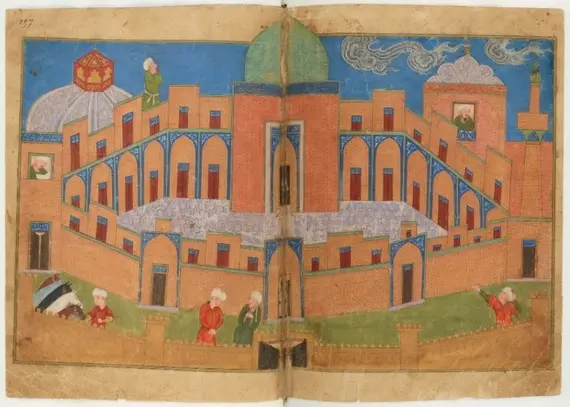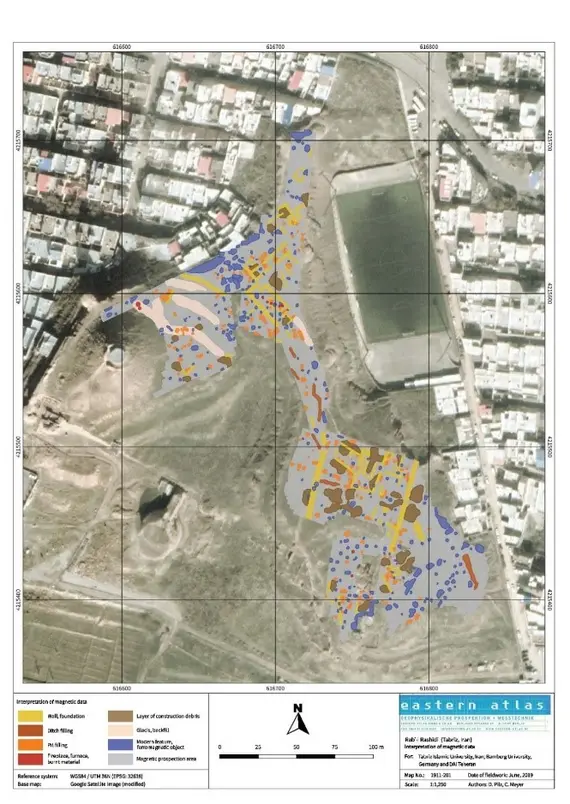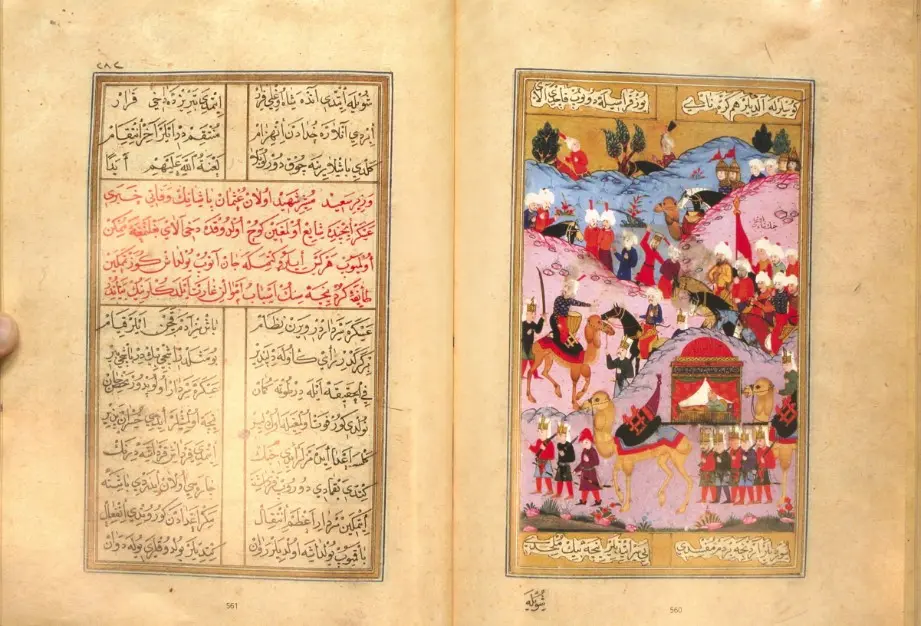Summary
The period of Mongol rule, with the Ilkhanid dynasty governing Iran (13th-14th cent.) presents problems of cultural change that can be described in terms of resilience and integration. This is visible in remnants of spectacular architecture and urban projects, as well as promising archaeological sites. Among these, the Rab?-i Rashidi in Tabriz stands out for its attested historical importance, its unique coverage by written documents about its foundation and functions, and for its accessibility for field research.

The Ilkhanid dynasty (c. 1256-1335) founded by Chingiz Khan’s grandson Hülegü, had a deep and long lasting impact on the political, social, demographic and cultural condition of Iran. For the first time after the Islamic conquest in the 7th century Iran regained the status of a distinct political-territorial entity. The Ilkhanid polity was encircled by hostile neighbors (Mamluks, the Mongol rulers of the Golden Horde and of the Ulus Chaghatay) - a situation that resulted in territorial confinement. The influx and permanent stay of a great mass of Mongols and Turks with of pastoral nomad background into a habitat characterized by agriculture and sedentariness meant a considerable challenge for the conquerors and the conquered alike. Entanglement between Mongol and Iranian elites was the result. Therefore phenomena and processes of resilience and integration can be observed on both sides. For maintenance of their nomadic lifestyle the Mongols had to concentrate in areas favorable to pastoral nomadism, i.e. the northern and northwestern territories of the Iranian highland. The Iranian administrative elite was constantly on the move together with the center of power, the royal encampment (ordu). The Ilkhanid rulers turned out to be passionate builders. They commissioned buildings alongside their seasonal routes of migration and initiated urban development or even the founding of new cities - directly as patrons or indirectly via their Iranian administrators. In the wake of earthquakes, war and deliberate demolition only few architectural or archaeological remnants of the Mongol period are still extant. This situation is aggravated by the fact that Iranian research has rarely considered the Mongol period a rewarding topic
For a better understanding of spatial concepts, patterns of migration and urban development our transdisciplinary project will evaluate textual and archaeological evidence. Spotting and mapping the routes of migration and the sites of seasonal dwellings into a geo-documented map has been a first objective of the project. The resulting map was to be used as a basis for local field research. One promising site is the vicinity of Bustanabad (60 km SE from Tabriz), which preliminary soundings have suggested as the location of the important seasonal residence of Ujan. Mongol agency in urban development also is reflected in the narrative and documentary sources of the period. In Tabriz, archaeological exploration of one of the largest pious foundation complexes of the period, the Rab?-i Rashi?idi, is under way in a German-Iranian project. In this case, too, textual evidence and archaeological evidence complement each other. The project aims at expanding and supplementing ongoing works, with excavations in three campaigns.
These goals became increasingly difficult to realise due to the Covid19 pandemic and subsequent developments. Most important, no fieldwork was possible in Iran during the years 2020-2022. Therefore, the research group laid the focus of their work on three aspects:
Further evaluation of the 2017-2019 fieldwork on the Rab?-i Rashidi area: From the excavated material and documentation of architectural remains, it was possible to form first (preliminary) hypotheses concerning the buildings of the founding phase and phases of later use.
Analysis of written sources on the water supply of the Rab?-i Rashidi: First and foremost, the foundation deed was to be confronted with the extant topography (preferably after historical aerial photographs and maps), to gain more clarity about hydraulic installations that were created with the foundation of Rashid ad-Din.
Evaluating written sources on the period of Ottman-Safavid conflicts in Northwestern Iran: A considerable number of Persian and Ottoman sources, which have not been evaluated (or even edited) in a satisfying manner, contain information about the Ottoman campaigns of the late 16th century, which led to the occupation of Tabriz several times, and about the Safavid re-conquests. Building activities are also reported. According to these sources, it appears highly unlikely that any parts of the Rab?-i Rashidi fortifications can be attributed to Ottoman activities.
Results of this research have been and are being published in numerous articles and presentations.
Articles
Christian Fuchs: A study of the defensive architecture on the site, in: Ahmad Mortazi (ed.): Proceedings of the First International Conference on the Commemoration of Rashid al-Din Fazl-Allah Hamadani (University of Tabriz, March 2021), Tabriz: University of Tabriz Press, 2021, pp. 265-294.
Birgitt Hoffmann: The Waqfna?ma-yi Rab?-i Rashi?di?– the most important written source for the understanding of the Rab?-i Rashi?di? endowment, in: in: Ahmad Mortazi (ed.): Proceedings of the First International Conference on the Commemoration of Rashid al-Din Fazl-Allah Hamadani (University of Tabriz, March 2021), Tabriz: University of Tabriz Press, 2021, pp. 337-348.
Lorenz Korn and Anja Heidenreich:The Site of Rab?-i Rashidi, Tabriz: Goals and Beginnings of the Iranian-German Research Project, in: Ahmad Mortazi (ed.): Proceedings of the First International Conference on the Commemoration of Rashid al-Din Fazl-Allah Hamadani (University of Tabriz, March 2021), Tabriz: University of Tabriz Press, 2021, pp. 295-314.
Thomas Lorain: The Rab?-e Rashidi archaeological campaign, Tabriz: Trench XII-XIII, preliminary results 2019, S. 315-336 in: in: Ahmad Mortazi (ed.): Proceedings of the First International Conference on the Commemoration of Rashid al-Din Fazl-Allah Hamadani (University of Tabriz, March 2021), Tabriz: University of Tabriz Press, 2021, pp. 315-336.
Thomas Lorain, Christian Fuchs and Lorenz Korn: Ilkhanid Tabrīz: Architectural and Archaeological Research on the Rab?i Rashīdī, Season 2019, e-Forschungsberichte des Deutschen Arch?ologischen Instituts eDAI-F 2022-2 § 1-35, doi.org/10.34780/3h77-denz
Birgitt Hoffmann: “The Mongol Ilkhanate of Iran: Realm or Empire?”. In: Empires to be Remembered. Ancient World through Modern Times, ed. by Michael Gehler and Robert Rollinger. Wiesbaden: Springer 2022, pp. 355-365.
Birgitt Hoffmann, Lorenz Korn, Jonas Elbers, Thomas Lorain, Maryam Moeini, Hossein Esmaili Atigh and Bahram Ajorloo: Prestigious Building and Urban Development in Ilkhanid Iran: The Rab?-i Rashi?di? in Tabriz as an Example of Resilience and Vulnerability in a Long-Term Perspective, accepted for: Reinhard Bernbeck et al. (eds.): Coming to Terms with the Future: Concepts of Resilience for the Study of Premodern Societies (Papers given at the opening conference of the DFG-SPP 2176: Iranian Highlands), Leiden: Sidestone, 2023, pp. 249-269.
Thomas Lorain, Lorenz Korn and Bahram Ajorloo: Preliminary results of the Iranian-German Archaeological Campaign at the Rab?-i Rashīdī in Tabriz, in: Nicolò Marchetti et al. (eds.): Proceedings of the 12th International Congress on the Archeology of the Ancient Near East Vol. 2 Field Reports – Islamic Archaeology, Wiesbaden 2023, pp. 867-877. DOI: 10.13173/9783447119030.867
Conference papers and public lectures
Members of the research group contributed to the conference held at the University of Tabriz with Dr. Bahram Ajorloo, Tabriz Islamic Art University , on 2 March 2021: “The First International Conference on the Commemoration of Khwaje Rashid al-Din Fazl-Allaha Hamadani”:
Birgitt Hoffmann: “The Waqfna?ma-yi Rab?-i Rashi?di? – the most important written source for the understanding of the Rab?-i Rashi?di? endowment”. Maryam Moeini gave an abstract in Persian of this paper
Thomas Lorain: The Rab?-i Rashīdī Archaeological Campaign, Tabriz: Trench XII & XIII preliminary results (2019)
Christian Fuchs: ?Rab?-i Rashidi. A study of the Defensive Architecture on the Site” (Christian Fuchs, M.Sc. is member of the Irano-German International Project of Rab?-e Rashidi antecedent and parallel to the Priority Programme)
At the 12th International Congress on the Archaeology of the Ancient Near East (ICAANE), Bologna, 6-9 April 2021, the project was presented with the following papers:
Maryam Kavyannia, Bahram Ajorloo, Thomas Lorain "The Rashidiyya in Tabriz: Review of 100 Years of Historical and Archaeological Investigations"
Christian Fuchs, Bahram Ajorloo: "Architectural Remains on the area of Rab?-e Rashidi, Tabriz"
Bahram Ajorloo, Lorenz Korn: "The Irano-German Explorateion of Rab'-e Rashidi, Tabriz, Iran: Recent Excavations and Interpretations (2019)"
At the webinar on the international Rab’-e Rashidi research project, organized by Tabriz Islamic Art University on 23 December 2021, the project was presented in papers given by Christian Fuchs and Lorenz Korn.
Further lectures and conference papers by members of the research group:
Lorenz Korn: "Rab'-e Rashidi: Recent Research on a 14th-century complex at Tabriz (Iran)", Eurasian Lectures on Tuesdays, Eurasien-Abteilung des Deutschen Arch?ologischen Instituts, online, 20. Oktober 2020
Lorenz Korn: "Rab?-e Rashidi: Arch?ologische und historische Forschung zu einem Stiftungskomplex des 14. Jahrhunderts in T?bris (Iran)", ?ffentlicher Vortrag im Arch?ologischen Kolloquium, Universit?t Bamberg, online, 12. Januar 2021
Thomas Lorain: “Fouilles du Rab?-i Rashīdī à Tabriz (Iran). Des sources à la réalité du terrain.”, Vortragsreihe von Prof. Elo?se Brac de la Perrière, Université Paris-Sorbonne, online, 12. M?rz 2021
Lorenz Korn "From waqf to Archaeological Site: The Rab‘-e Rashidi (Tabriz)", Vortrag auf dem 4e Congrès des études sur le Moyen-Orient et les mondes musulmans, Universit?t Aix-en-Provence (online) 28. Juni – 2. Juli 2021
Birgitt Hoffmann: “Ilkhanid approaches to appropriate, capitalize and develop the lands under their control: ways of land tenure, providing infrastructure and building politics”, Vortrag auf dem Workshop des SPP2176 "Institutional Landscape and Empires in Ancient Iran", Istanbul, 4.-7.Juli 2022


